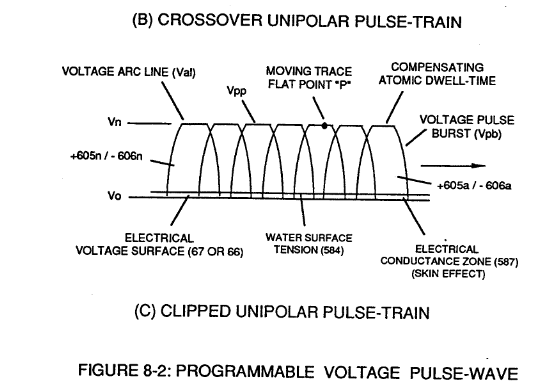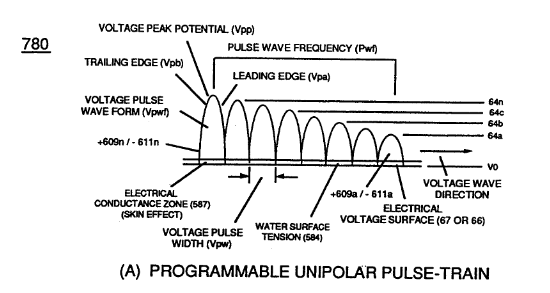# 8-5 - Energy Vectoring (Ev)
The "mode of operability" of determining the "Operational Parameters" of adjusting the thermal explosive energy (gtnt) exiting from nozzle-port (32) of Figure (4-5) as to (40) of Figure (4-2) is directly related to the characteristics of the applied **Voltage Pulse Potential (Vpp) Wave-form (s) (Vpwt)** and the geometrical configuration of **Resonant Cavity** (90) of Figure (4-7) as to (730) of Figure (7-12).
In terms of Voltage Pulse Wave-form (s) (Vpwt) several ''**Electrical Operational Parameters**" exist:
**Dynamic State Space (Dss)** which continually changes/varies Electrical Attraction Force (RR' - SS' as to RU/RU' - ST/ST') from low stress intensity (S-low) to high stress intensity (S- high) and back to low stress point (S-low) as to **Arc Curve (Vac)** forming **Voltage Pulse Field (Vpt)** atop **Voltage Pulse Burst (Vpb)** ... which combined together (Vpf + Vpb) Electrical Stress (Es) variances corresponds to the **Voltage Pulse Shape** of each synchronized **opposite Voltage Pulse Wave** (583 - 602) of (770A) of Figure (8-1) being produced during applied **Voltage Pulse Operation** (49a xxx 49n);
**Static State Space (Sss)** is the electrical condition by which Electrical Attraction Force (RR' - SS' as to RU/RU' - ST/ST') is being held constant once **Voltage Pulse Burst Vpb)** occurs during **Voltage Pulsing Operation (Vpwf)** ... forming synchronized **Clipped Voltage Wave-form** (780C) of Figure (8-2) in like manner to voltage sync-pulse (583 - 602).
| **Clipped Voltage Wave-form** (780C) of Figure (8-2)
[](https://stanslegacy.com/uploads/images/gallery/2023-12/7QsOG4PnzICQjKMn-image-1702320617032.png)
|
In the area of **Voltage Sync-Wave** (+/-) propagation, **Unipolar Voltage Pulse Train** (583/602a xxx 583/602) of (770A) of Figure (8-1), **clipped Voltage Pulse Train** (605/606a xxx 605/606n) of Figure (780C) of Figure (8-2), and **Crossover Unipolar Pulse Train** (607/608a xxx 607/608n) brings-on **Static Voltage Stimulation (Vsvs)** by which **Static Electrical Charging Effect (585)** is being held constant since **Electrical Stress Force (Est)** averages out either Dynamic State Space (Dss) or Static State Space (Sss) during repeated pulsing operation (49a xxx 49n).
[](https://stanslegacy.com/uploads/images/gallery/2023-12/30pB35kz5zZPgP7W-image-1702320882250.png)
On the other hand, **Progressive Voltage Sync-Wave** (+609 / - 611) (609/611a xxx 609/611n) of Figure (780A) of Figure (8-2) encourages **Dynamic Voltage Stimulation (Dvs)** since **Voltage Peak Potential (Vpp)** increases as **Voltage Sync-Wave Front** (a to b to c and so on) advances in the number of **Unipolar Voltage Pulse (s) (Vwp)**, as illustrated in Figure (3-21) ... causing Dynamic State Space (Dss) or Static State Space (Sss) to be progressively increased in **Electrical Stress Intensity (Esi)** during a given space-time continuum
... producing **Dynamic Electrical Charging Effect** (612) of Figure (8-1) that increases Electrical Stress Pressure (Espa + Espb + Espc, and so on) continually during each gated voltage pulsing cycle (49a xxx T3 xxx 49n).
To further adjust incoming **Voltage Priming Stage (Vps),** Unipolar Voltage Pulse Train (Vpt) is either gated full-on to allow space-time continuum or back-off in gated format from 100% to a lower percent (%) of Pulse-Frequency on-time, as illustrated in Figure (3-20).